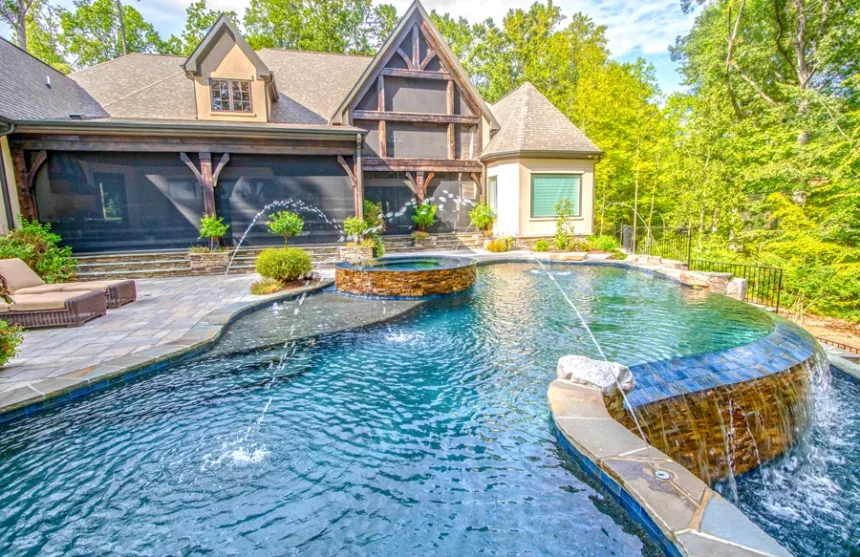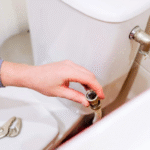For decades, white plaster was the default finish for in-ground pools. It was simple, smooth, and affordable. But over time, more pool owners are saying goodbye to basic plaster and choosing pebble pool finishes instead.
At first glance, pebble might seem like just a style choice. It looks natural and gives the water a rich, sparkling color. But there’s more to this trend than pretty textures. Pebble finishes last longer, resist damage, and can even save you money in the long run.
Let’s break down exactly why plaster is fading out and pebble is rising to the top—and why your pool might be the next to make the switch.
The Basics: What’s the Difference Between Plaster and Pebble?
Plaster – The Old Standard
Plaster, also called marcite, is made from a mix of cement and crushed marble. It gives pools a smooth white surface that’s clean and bright. Plaster has been around forever, and while it’s still popular in budget builds, it comes with some drawbacks.
- Prone to cracking
- Can stain easily
- Feels smooth at first but gets rough over time
- Lifespan: about 5–10 years
Pebble – The Natural Upgrade
Pebble finishes, like PebbleTec®, are made from small natural stones mixed into a strong cement base. These stones create a textured surface that’s both tough and beautiful.
- Stain-resistant
- Durable and long-lasting
- Comes in many colors and styles
- Lifespan: 15–20 years or more
Why Pebble Is Taking Over Backyard Pools
It Lasts Way Longer Than Plaster
One of the biggest reasons people switch to pebble? Durability.
While plaster might give you 5–10 good years, pebble can last 15–20 years—even longer with regular care. That means fewer resurfacing jobs, fewer maintenance calls, and more time enjoying your pool.
Bonus: Pebble doesn’t wear down the same way. It stays looking great year after year.
It Handles Harsh Pool Chemicals Better
Pools need chemicals like chlorine to stay clean. But those same chemicals can break down plaster over time, leaving it rough and stained.
Pebble holds up better. Its tough stone surface doesn’t react as easily to harsh chemicals, making it a better fit for pools that are used a lot or need frequent shock treatments.
It Stands Strong in Extreme Climates
In places like Phoenix, Dallas, or Las Vegas, where it’s hot and dry, plaster tends to dry out, crack, or flake. In cold spots like Denver or Minneapolis, freezing and thawing can damage plaster quickly.
Pebble finishes, on the other hand, flex better with temperature changes and don’t crack as easily. If your climate is extreme, pebble’s a smarter long-term choice.
It’s Not Just Durable—It’s Drop-Dead Gorgeous
More Color Options = Better Water Aesthetics
Pebble finishes come in dozens of colors—from cool blues and tropical teals to earthy grays and bold blacks. The finish you pick affects how the water looks—light blue, deep blue, turquoise, even emerald green.
Plaster? It’s mostly white or gray, and those stain fast.
Natural Stone Texture Looks Luxurious
People love that pebble has a natural, lagoon-like look. It blends better with landscaping, feels high-end, and gives your pool a custom vibe. Plaster, by comparison, can feel plain or dated—especially after it starts to age.
Is Pebble Rough on Your Feet? (Short Answer: It Depends)
Some homeowners worry that pebble finishes are too rough. And yes, pebble does have texture—it’s not glassy-smooth like new plaster.
But there are options. Finishes like PebbleSheen® or mini-pebble mixes use smaller stones, giving you a smoother feel while keeping all the strength of a regular pebble finish.
Plus, some people actually prefer the grip. If you’ve got kids running around or don’t want to slip on the stairs, that texture is a win.
What About the Cost? Is Pebble Worth the Upgrade?
Upfront Cost: Yes, Pebble Is Pricier
- Standard Plaster: $4,000–$6,000 (depending on pool size)
- Pebble Finish: $8,000–$12,000+
That’s a noticeable difference. But let’s look at the bigger picture.
Long-Term Value: Pebble Pays for Itself
Since plaster needs to be replaced every 5–10 years, you might end up with pool resurfacing twice in the same time pebble lasts. Add in the costs for patching, stain removal, and extra cleaning, and plaster ends up costing more over time.
Pebble is a one-and-done finish for many pool owners. Fewer problems. Fewer repairs. Better resale value.
Who’s Switching to Pebble? Pretty Much Everyone
Homeowners Doing Full Pool Renovations
If you’re already upgrading tile, coping, or pool decking, now’s the time to ditch plaster. Going pebble gives your pool a full transformation—and keeps the new look going for years.
People Buying or Selling Homes
A fresh pebble finish can boost a home’s curb appeal and value. It shows buyers the pool has been cared for, and that they won’t need to pay for resurfacing anytime soon.
Vacation Rentals and High-Use Pools
Pebble stands up to heavy use, so it’s ideal for Airbnb hosts, vacation homes, or busy households with lots of swimmers.
Conclusion: Pebble Isn’t Just Prettier—It’s Smarter
Pool owners aren’t switching to pebble just for the looks—though that’s a big part of it. They’re choosing it because it lasts longer, resists damage, and makes pool care easier.
If your plaster is rough, stained, or cracking—or if you’re building a new pool—think long-term. Pebble finishes may cost more upfront, but they save money, headaches, and time down the road.
So yeah, plaster had its time. But pebble? Pebble’s the future.


